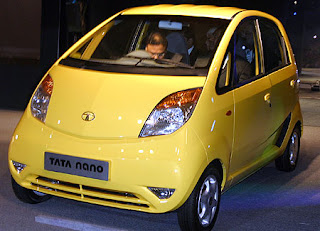Tata Reveals Its Nano, A $2,500 New Car
 India’s largest automaker (and future owner of Jaguar and Land Rover) Tata has come through in its pledge to reveal a $2,500 “people’s car.”
India’s largest automaker (and future owner of Jaguar and Land Rover) Tata has come through in its pledge to reveal a $2,500 “people’s car.”
Clearly, you don’t get a lot of luxury or power for $2,500. The car is powered by a 33 horsepower, 624 cc (0.6 liter) two cylinder gasoline engine, connected to a CVT. It has a top speed of 104-105 km/h (65 mph). The car will seat five people, and is designed to bridge the gap between motorcycles and traditional minicars – which are larger than the Nano.
Ratan Tata, chairman of Tata Group, said at the car’s unveiling in India earlier today that he was struck by how many families were traveling unsafely aboard motorized scooters. “I’d go along the road and see the father driving with a kid sitting in front of him on the tank and the wife behind holding a baby. And I’d think ‘Oh, my God, that’s so dangerous.’ It just got to me.”
Tata said that the initial concept for the project was a soft-top rural vehicle, but the end result is a conventional automobile that meets international offset and side-impact tests. Tata believes that it can earn a profit on the Nano, and part of its business plan is to offer better-equipped, higher-priced versions elsewhere in the world. The car will be sold in India only for its first two years, and will later be sold in other developing markets such as Africa, Latin America, and Southeast Asia. Later, better-equipped versions sold in Europe may cost three times as much and include larger engines or diesels, but a $7,500 new car is still very affordable, particularly in a developed market.
The Nano has the potential to revolutionize the global automobile industry. Tata has proven that cars don’t need to weigh two tons to meet crash-test standards, and also proven that a new car doesn’t have to cost $10,000 and up to get newly mobile families on the road. I can’t wait to see what Renault’s response is, since they have also announced plans for a car for developing markets that costs about half of what its Logan does. Also, will the lessons learned by Tata in lowering costs be applied elsewhere in the auto industry, pushing down prices for mainstream vehicles – or even Jaguar and Land Rover? It will be interesting to watch.




